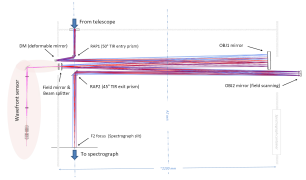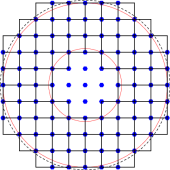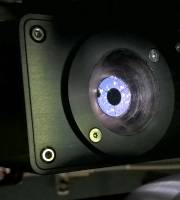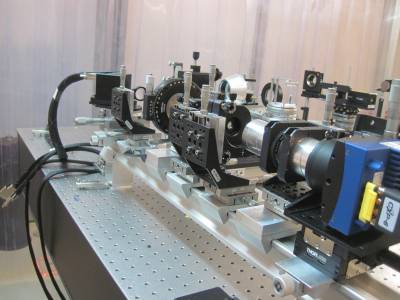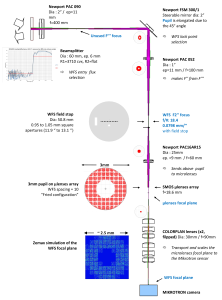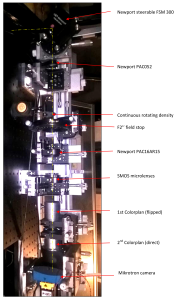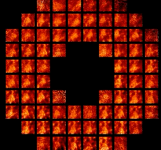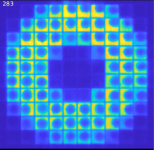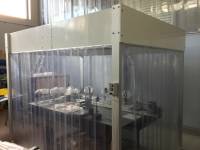Table of Contents
The TAO (Themis Adaptive Optics) system
— This page is currently being developped: we apologize for the inconvenience[BG+MT] Feb 3rd,2021 16:10
NB: our full technical library is on this other page.
TAO is a single conjugate adaptive optics (AO) system with only one deformable mirror conjugated to the lower atmospheric layers, responsible for most of the observed daytime turbulence at our site.
TAO is inserted in the light path after the telescope and the transfer relay optics, between the (intermediate) F2' focus and the F2 focus at the spectrograph entry (Fig. 1). The TAO layout requires two horizontal folds of the beam, then returning it to a vertical path on the same downstream axis (Fig. 2). A beam splitter (with some power) feeding the wavefront sensor with a fraction of the light is located between the two folds. The combination of OBJ1 and the beam splitter transports (and amplify) the DM pupil on the OBJ2 mirror, which is de-facto our beam steering mirror, allowing to scan the field on the spectropgrah slit. OBJ2 itself also creates the F2 focus on the the entry slit.
The field of view of the wavefront sensor (11“) is a trade-off between a larger fov (for better correlation of solar surface features) and the available processing speed (limiting the amount of pixels to process given our computing power). The deformable mirror specs are also a trade-off that includes the small available physical volume that limits the pupil size to 10-20 mm, the simultaneous needs for large stroke and fast response time to allow only one mirror for both the tip-tilt and the higher order corrections, the fitting error deriving from the the number of actuators, and… the available funding.
|
Fig.3: TAO geometry showing 97 actuators on a 11 × 11 grid, and 76 subapertures on a 10 × 10 grid. The red circles mark the pupil imprint with its central obscuration, and the dashed circle represents the diaphragm on the deformable mirror. |
The combination of DM/wavefront sensor is setup to work in a so-called 'Fried configuration' with a spacing number of 10, as shown on Fig. 3.
Deformable mirror
We are using an ALPAO DM97-15 mirror(1), made of a thin reflective membrane connected to magnetic voice coils actuators. This is the “high-speed” version of this mirror, with up to 30µm of available total stroke and an above 1kHz bandwidth. This DM technology is actually a nice balance between stroke and speed, as the amount of daily turbulence at the site can be impressive (equivalent tip-tilt seeing of several arcsecs, or many lambdas).
|
Fig.4: The ALPAO DM97-15 in the sunlight. The visible notch in the pupil comes from an inlined guider mirror which is removed when the AO system runs. |
This mirror has 97 actuators set on square grid pitched at 1.5mm, and provides 13.5 mm of useful reflective area in factory settings. We did request a custom setup to allow using a 15mm reflective area better suited to our final WFS geometry.
A specific challenge we had to figure out immediately has been the flux load on the deformable mirror: one 15 mm pupil receiving the full telescope heatload has the same kind of concentration of power as our F1 focus (e.g. about 9 times the natural sunlight). While this mirror is used in several other solar telescopes (Hida Observatory DST, VTT at OT …), none of these are comparable to THEMIS in collecting power. Since 2018 we have not noticed any ageeing of the DM reflective part and we have checked that the static and dynamic DM specs are not changed under that solar flux, confirming this model is suitable for our observations.
Wavefront sensor (WFS)
The WFS is fed from the main beam trough a 92-8 % beam splitter. Space considerations forced us to relocate it outside of the spectrograph enclosure (where is the main path located), so that the WFS bench is setup vertically on an extra optical table hanging on the spectrograph external wall.
It is a classical Shack-Hartmann type using SMOS microlenses (2). It images the solar focus on a stop plate that sets the available fov to 11”. The WFS was planned with an entrance 500nm green filter but actually works nicely in white light. Below the focus, we form a 3mm pupil over the microlens plate, pitched at 300 µm, hence a 'filling factor' of 10. The final setup between the microlenses and the DM is that of a Fried geometry, with the DM actuators projecting at the vertices of the microlens array.
The subpupils created at the focus of the microlens array are then scaled and re-imaged over the fast camera/grabber assy. This reimaging is made necessary by the very short focal lenght (15mm) of the microlens plate, otherwise an in-depth hardware stripping of our fast camera would be required (somehow out of our scope).
Our camera is a Mikrotron EoSens 4CXP-6 (3), with 7μm pixels, 10bits. Camera FPS is up to ~1500 for an ROI of 400×400 pixels, including the exposure time and the real-time server sofware overhead (this is the end-to-end value and not the camera spec). - 68 SUB-IMAGES of 29×29 pixels (11.5×11.5arcsec2) - scale: 0.4 arcsec/pixel
The WFS can work in several modes :
-
Solar wavefront sensing (main mode)
-
F2' pinhole with solar light (soon to become a laser pinhole), for zero reference, interaction matrix and non-common path abberration (NCPA) calibrations.
-
F1 laser mode (as an alternative to the F2' calibrations)
Differences in flux between these modes are handled with a variable neutral density plate.
Fig. 8 & 9 show the actual output of the WFS camera.
Integration and tests at CRAL (2016-2018)
The complete AO bench has been first integrated in Lyon, in the same configuration as it would be on the telescope, but for the spatial orientation of the whole setup which was horizontal on an optical table at CRAL, while it is vertical in the telescope. The setup included:
-
a red laser/ color tunable light source simulator, including a realistic THEMIS telescope pupil
-
the main TAO path as described above
-
the wavefront sensor branch fed through a beam splitter, as above
-
the WFS and field cameras and their computer interfaces
-
The instrument CPU
(…)
Computer and software
The wavefront sensing and mirror commanding software runs on a typical high-end desktop PC using a Linux (Mint) kernel 3.19.8-031908-lowlatency x86_64 operating system, and featuring:
-
Mobo: ASUSTeK model: Z97-A
-
Quad core Intel Core i7-4790K (-MCP-) cache: 8192 KB clock speed max: 4400 MHz
-
16 GB DDR3 DIMM speed: 2400 MHz type
The real-time software is built using a Toolkit for Adaptive Optics developped at CRAL (Ref).
(…)
(1) ALPAO mirrors
(2) SMOS - Smart Microoptical Solutions
(3) Mikrotron GmbH
© 2025 CNRS-THEMIS
Terms of use: unless otherwise specified, all graphical (webcam records, movies, pictures) or non-graphical material (text) from this site is property of CNRS-THEMIS under a Creative Commons CC-BY 4.0 license.


